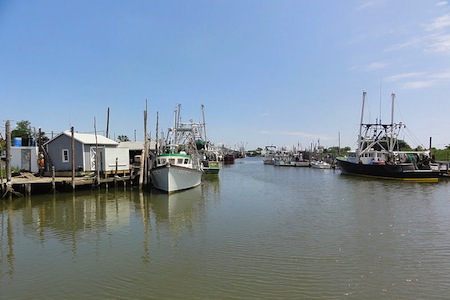Reclaiming Our Coasts and Shorelines
Belford Harbor, NJ -- a relatively rare example of a working harbor on the modern Atlantic Coast. Credit: Wiki Commons.
 Chances are that in a few months Hurricane Sandy will be forgotten.
Chances are that in a few months Hurricane Sandy will be forgotten.
Politicians are already talking about rebuilding and restoring, wholly ignoring the fact that coasts have always been the most changeable of all American landscapes. As places where water and land coexist, where, as Rachel Carson put it, "today a little more land may belong to the sea, tomorrow a little less," shores are in perpetual transformation.
Today more of us live on coasts than ever before. Once thought of as inherently dangerous, coasts are now the most coveted real estate on Earth. Just over 50 percent of Americans live in what are designated coastal zones, which make up only 15 percent of America's territory.
But the coasts we have returned to are not those our ancestors would recognize. Working waterfronts are gone, fishing has collapsed, and shipping has moved elsewhere. America's great seaports have lost not only their wharfs but their sailor towns. Those who now occupy the high-priced condos in New York's Battery City are there to recreate and consume. Their contact with the sea is visual and, though they live on the sea, they do not have the slightest idea how to live with it.
Coasts have been engineered to suit the interests of resort owners and land developers, and in the process have become increasingly vulnerable. They have become the hard edge of the land rather than a transition zone of tidal basins and wetlands, which have been diminished by as much as 80 percent. Ironically, the seawalling of shores has made them more rather than less vulnerable, subject to unprecedented storm surges, erosion, and pollution. They no longer support fish, birds, and marine mammals. And to the list of endangered species must be added human beings, especially homo littoralis -- that is, people of the seashore.
There was once a time when the traces of disaster lingered longer in the form of wrecked ships or the bones of beached whales. Now the shore is quickly cleared, the sands cleansed, and everything restored to the pre-disaster status quo. For centuries the Japanese erected tsunami stones at the high-level points of sea surges, but in recent decades even they have abandoned this useful practice. Today, only a vague memory remains.
But it is not just the memory of particular events that has been erased. Shores have become our chosen places of forgetting. They are where we go to turn our backs on the past, on the world at large. The entire history of coasts and coastal people has been forgotten. Indeed, the shore has become the place where nothing is supposed to happen, a place that offers retreat from the frenzied pace of our everyday lives. The people who might be expected to have longer memories -- fishers and sailors -- are now only a tiny minority of those who live on the coasts. They have been priced out of shorefront property by newcomers who have scant experience of the sea. What little of the coastal past remains is to be found in maritime museums and antique shops.
This does not bode well for the post-Sandy eastern shore.
Just as the "eternal sea" is viewed as something that never changes, so we view, despite abundant evidence to the contrary, the coast as timeless, existing apart from history. America has forgotten that it was once the most coastal of all nations, discovered and then settled by sea and so economically dependent on the sea that in 1837 Alexis de Tocqueville predicted for it a glorious maritime future. Shores have always been America's most dynamic as well as most biodiverse geography.
So let's recover our coastal history. It will do no good simply to place a plaque where a house once stood. Instead, let us learn to see Sandy as part of the long, highly instructive environmental and human history of coasts and coastal peoples. For it is only through the past that we will fully understand our present predicaments and future possibilities. In this epochal event we are witnessing the inseparability of human and natural history.
It is time to step back, both literally and figuratively, to learn from earlier generations who knew how to live lightly and flexibly on the shore. We need retreat from the most vulnerable shores and restore wetlands and barrier islands to soften the blow of sea surges. We might even borrow from the Netherlands plans for floating cities. That may sound futuristic, but practical architectural and engineering projects are currently under way. Above all, we need to learn to work with the sea, rather than against it, heeding Francis Bacon's dictum: "Nature, to be commanded, must be obeyed."
This not the time to rebuild on the footprint of ruined shores, but a moment to establish a respectful relationship between land and sea.

